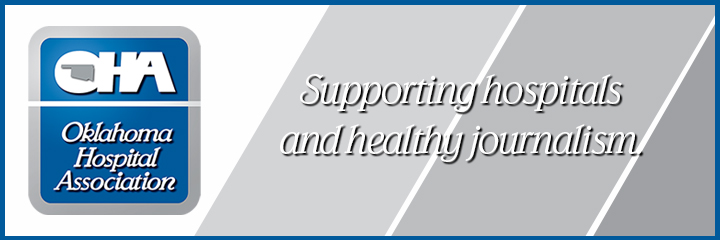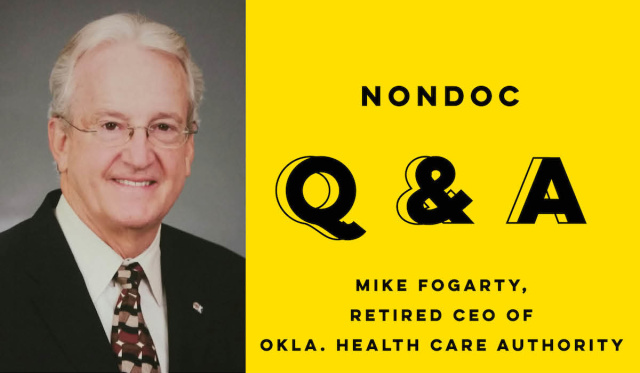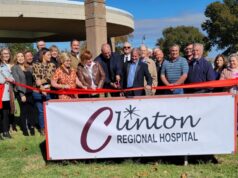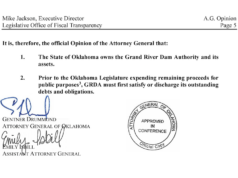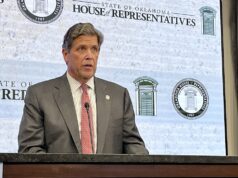
For 13 years, Mike Fogarty served as CEO of the Oklahoma Health Care Authority. During that time and since his retirement in 2013, the Guthrie native has witnessed many changes within Oklahoma’s health care landscape.
Below, Fogarty divulges his insights into the Affordable Care Act’s far-reaching effects on health care policy in Oklahoma, his take on the recently proposed “Medicaid rebalancing” strategy, and the difference between true leadership and political leadership. Responses have been lightly edited for style and grammar.
What’s something that most Oklahomans don’t know about their state’s Medicaid/SoonerCare system?
Most may not know the transition from “Medicaid” to “SoonerCare” was way more than a name change. They may be unaware that, since its creation, Medicaid federal law limited coverage to not only those who met financial eligibility, but also required they be elderly, totally disabled or a family with children. This limitation contributes to the fact that more than 26 percent of Oklahomans ages 18 to 34 have no health insurance.
Many Oklahomans may also be unaware of progress made to overcome these limitations. Between 1995 and 2005, the Oklahoma Legislature authorized a number of changes to take advantage of new federal policies that gave opportunity to expand coverage to meet critical needs for improving access and health outcomes. It’s about affordability. Care and treatment for pregnant women and children was greatly improved by raising income standards, followed shortly by an increase in qualifying income standards for elderly and disabled adults. Other new opportunities were realized, including: Oklahoma Cares (coverage of women diagnosed with breast or cervical cancer), SoonerPlan (offering family planning benefit to Oklahomans ages 19 and above), and TEFRA (allowing coverage for severely disabled children living at home).
The creation of Insure Oklahoma represents a most significant change in the use of Medicaid-funded health coverage. It offered access to income-eligible working Oklahomans regardless of age or disability. Federal approval was available only as a result of cost savings ($2 billion plus) attributable to the Oklahoma managed-care demonstration known as SoonerCare.
Looking back at how the Affordable Care Act has unfolded over the past six years, what has been a pleasant surprise and what has been a disappointing surprise?
Disappointment came first when Gov. Mary Fallin reversed her earlier announcement that the insurance marketplace exchange would be built for Oklahomans, by Oklahomans. We had been awarded the largest ($54 million) of only seven federal grants to states to design, build and operate the state exchange through which Oklahomans would compare and enroll in the health plan of their choice. Instead, Oklahomans had to endure the delays and confusion caused by defaulting to a hastily built federal stand-in for what would have been the nation’s best state exchange.
An unforeseen, but most pleasant, development occurred when our neighboring state of Arkansas implemented a virtual copy of the Insure Oklahoma premium-assistance plan. Arkansas was granted federal approval to use the Arkansas Health Care Independence Program for its ACA-qualified Medicaid expansion. In its first year, the Arkansas version of Insure Oklahoma is credited with primary responsibility for reducing the Arkansas adult uninsured rate by 45 percent and the hospital uncompensated care rate by 55 percent.
While not qualifying as big surprise, I must add that I’m very disappointed that we have not taken advantage of the enormous opportunity to help thousands of Oklahomans avoid needless suffering and premature death, not to mention returning hundreds of millions of our federal taxes to Oklahoma, creating thousands of good jobs and stimulating growth in the Oklahoma economy.
“Medicaid rebalancing” was a buzzword thrown around during this past legislative session. That proposal would involve accepting Medicaid expansion dollars while transitioning some existing SoonerCare beneficiaries to the online marketplace for private insurance. What are your feelings on that plan?
I believe the proposal is a great opportunity to make health coverage affordable for all Oklahomans living in poverty. For newly qualified adults, it looks exclusively to Insure Oklahoma for coverage. As we have seen, the plan is proven both effective and approvable by the federal government as an ACA-funded alternative.
As already mentioned, Oklahoma stepped up long before the ACA was enacted to offer coverage to pregnant women, children and others with specific health needs in families with modest but well above the federal poverty level income, for whom health insurance is unaffordable. It seems reasonable to assume those with higher yet modest income would be effectively helped by the premium subsidy provided through the ACA federal income tax credit. I do think we should carefully monitor that transition to assure that they are not disadvantaged.
To what do you attribute Oklahoma politicians’ reticence to accept federal Medicaid expansion funding?
Beyond simply partisan gridlock between elected officials at both the state and federal levels, I believe unique events set in motion the Medicaid expansion boycott by Republican office holders.
First, in the drafting of the ACA, a decision was made that, rather than creating a new national health plan for our nation’s poorest adults, we would create nationwide coverage by mandating it through the state-run Medicaid program. While Medicaid itself is optional for states, it has been commonplace throughout its 50-year history for Congress to expand coverage by either mandate or by inducement through targeted increases in federal financial participation. With few exceptions, states have opposed (unsuccessfully) every new mandate as an infringement upon their administrative discretion and, most vigorously, as an unreasonable financial burden upon states by the federal government. The Medicaid expansion mandate quickly became the primary opposition target of Republican governors and state legislators in spite of the highest federal financial participation in the history of Medicaid.

Finally, when the U.S. Supreme Court determined that this, and only this, was the one provision of the ACA that was unenforceable, it in effect made the Medicaid expansion an option of the state. Having linked arms in loud protest against the mandate, the Republican opposition has had little choice but to refuse the expansion and the money. I believe that, had the mandate survived, the opponents would have grumbled and implemented the expansion.
Ultimately, I think (hope?) many would have been quietly pleased with the result. I also believe that, had the drafters of the ACA had any inkling of the risk and had made the expansion optional, every state would have soon opted to expand, just as every state opted to have a Medicaid program in the 1960s even in the face of strong opposition.
Put on your fortune-telling hat for a minute and describe to us how you believe the health landscape will change by this time next year.
I believe that 200,000 Oklahomans will have newly acquired Insure Oklahoma health coverage and many thousands more will have purchased insurance with help from federal premium assistance. Oklahoma’s rate of uninsured will be on its way down to 5 percent. Hospitals throughout the state will be in financial recovery, with drastically reduced uncompensated-care costs. Several recently closed rural hospitals will reopen and thrive. Medical professionals will be attracted to our now-robust marketplace and wholesome Oklahoma lifestyle. Oklahoma’s workforce will be healthy and strong, and, most importantly, 25,000 of our friends and family will not die needlessly but will live healthier, happier lives.
But how, you ask? The Legislature will meet in special session very soon to take advantage of the opportunity to return our federal tax dollars to Oklahoma and improve the health of our great state.
Imagine that you find yourself trapped in a room with a bunch of college students who, one day, will all grow up to be political leaders in Oklahoma. What advice do you offer them about health care policy?
Think about which is most important in your public service as a political leader: politics or leadership? It is likely that as you mingled with your fellow Oklahomans today, only three out of four adults you saw had some form of health coverage that gives them access to needed care. The politics of political leadership focuses on the three, while the leadership includes all four.
Did you see anyone that deserves to suffer and die due to lack of access to health care? If leadership is your choice, your service must include helping the three see that it is up to all of us to help the one, and that, in fact, helping the one is in the best interest of all four.
Most importantly, leadership is doing the right thing, whatever the political risk.
